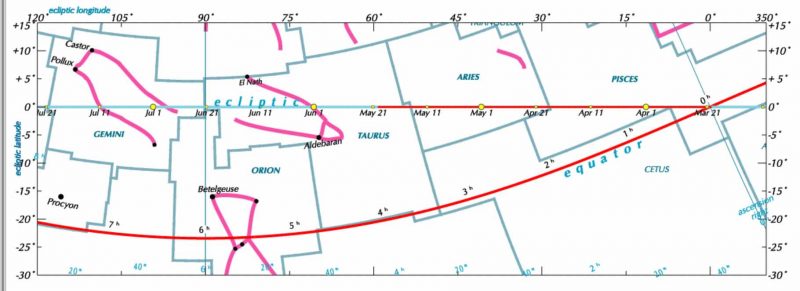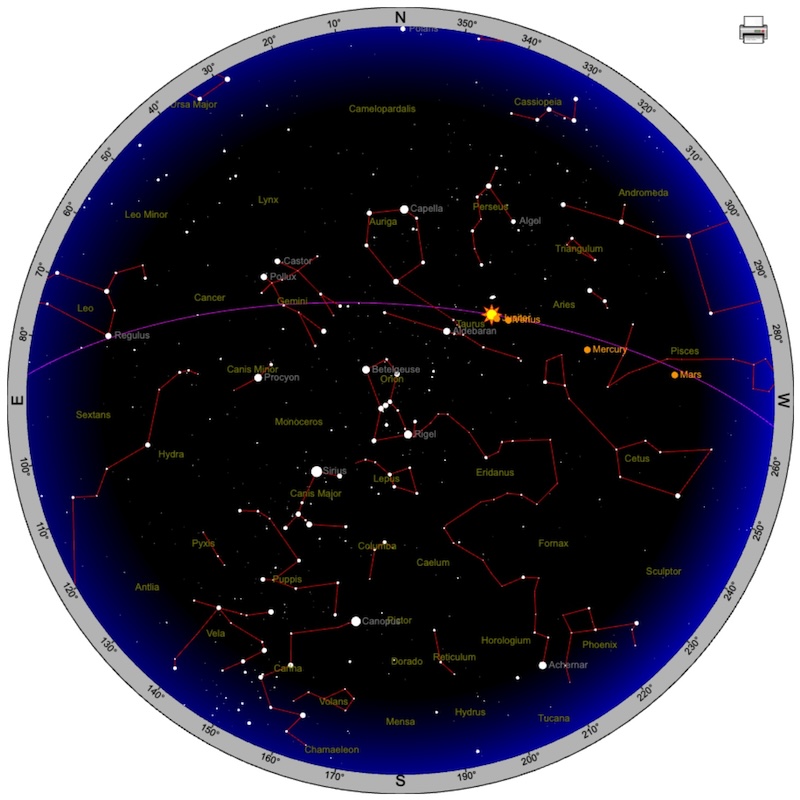
Constellations and astrological signs
At 13 UTC on May 20, 2024, the sun will enter the astrological sign of Gemini. But – in the real sky – the sun doesn’t cross into the constellation Gemini until a month later, June 21, 2024, at 9 UTC.
What gives? Why is there a difference between signs as defined by astrologers, and constellations as defined by astronomers?

The signs of Aries, Taurus, etc. – still used in astrology – are 30 degree-wide bands along the ecliptic, starting at longitude 0 degrees. This is also known as the First Point of Aries. The constellations are areas of the starry sky, defined since 1930 by specific lines and boundaries. The two coincided, somewhat over 2,000 years ago, when the system of astrological signs was defined. But precession – the wobbling of Earth’s spin axis over a cycle of 25,800 years – has made them increasingly divergent.
The sun’s path through the sky
The chart at the top of this post shows the sun’s travel from around March 20, 2020, (the spring or vernal equinox) to May 20, 2024. You can see that the sun does indeed reach longitude 60 degrees on the ecliptic. But this brings it to the beginning (roughly) of constellation Taurus, not Gemini. It will have to travel another 30 degrees – one month – to enter Gemini.
The stars and constellations stay fixed. What shifts over time is the celestial equator – the “belt,” you could say, of the spinning Earth – and the mapping system based on it.
Picturing constellations and signs
Mentally move them. Imagine the sun’s March-to-May track, and the celestial equator – the two features I’ve emphasized with red on the chart above – slid 30 degrees to the left (east), while everything else stays in place. The crossing-point of equator and ecliptic – which is the zero point for longitude – is 30 degrees to the left: it is at what is now longitude 30 degrees, the beginning of Aries. So it really is then the First Point of Aries. In this mental projection, the sun is at the First Point of Aries in March, and arrives at the gates of Gemini at this time in May.
This was how things stood when the system of signs was agreed upon, around 2,000 years ago.
You can, with some imagination, see it in your sky, or on the chart at the top of this page.
There is the sun (below the horizon) at its May 20, 2020, position where it enters the astrological sign of Gemini. If this were 150 BCE it would be 30 degrees on, at what is now longitude 90 degrees – the solstice point of our time, by the feet of Gemini.
Bottom line: When – astrologically – the sun enters the “sign” of Gemini, it is still nearly one month away from entering the constellation Gemini in the sky.
Check here to see what constellation the sun is in today.
Check here to see where the sun is today in its astrological sign.











